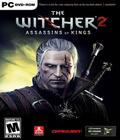Sometimes, the quietest things at E3 are the best. The cubicle-based meeting areas at the back of the Los Angeles Convention Center are mercifully free of E3's signature cacophony. Just as significantly, though, sometimes the smallest, quietest booths show off some of the best games at the show. Atari, with only six computers, showed off one of the best right out the gate with CDProjekt Red's sequel to the The Witcher.
The Witcher is based on a Polish series of novels and short stories that center on Geralt of Rivia, the titular Witcher who has been enhanced at a young age to fight monsters (think the high-fantasy version of the Master Chief, and you'll be on the right track). In The Witcher 2: Assassins of Kings, Geralt find himself in way over his head in the traditional fantasy explosion ... again. The plot is apparently new and isn't just a version of one of the novels.
The first thing that jumps out about the game is the camera switch. Everything looks a lot smoother, as CDProjekt Red has replaced the Neverwinter Nights' Aurora Engine with an original engine that revises all sorts of small and large elements of the game's five acts. The results also seek to have the world significantly change as a result of player actions and morality (or lack thereof), from wide to small details. The Witcher 2 uses full background loading to shorten load times and ensure that environments and cut scene switches occur quickly.
As a demonstration of the combat, we see Geralt and two friends land their ship, and they are almost immediately attacked by a bunch of elves. One ally tosses up a shield to block the streams of arrows, while foes who come in close are Geralt's to handle. The new combat system is freer than before, no longer requiring precise timing to land combos, while also making them look more natural than before. This iteration also provides complete support for Xbox 360 controllers, for those who care to play with them. (The possibility of a console port after completion of the PC version has intentionally been left open.)
After the skirmish, group arrives in a small community. Little is shown here, but the CDProjekt rep noted how the community members have individual motivations and behaviors. When I asked if the Dreamcast classic Shenmue was a valid comparison, he immediately nodded but also pointed out how actions could change behaviors more. As he brought Geralt toward a town square, a person with whom Geralt needs to speak turns up on the podium ... with a rope around his neck. The ensuing scene of talking down the executioner is a framework to demonstrate the new conversation system and accompanying techniques.
Not only does the conversation involve Geralt and the executioner, but the crowd also reacts: New people come into or leave the conversation, and the executioner even flips the switch to hang an Elven woman. These dynamic conversations are the developer's primary reason for creating a new engine, since the Aurora Engine couldn't provide the movie-like, dramatic scenes that are present in The Witcher 2.
The final demonstration highlights one of the boss battles: a giant, squid-like creature. The basic action-RPG controls are switched out for Quick Time Events (QTEs), which pop up at certain points in the fight. Geralt has to get the creature to smash a bridge above it to pin it down so he can jump in for the killing blow. The results surprisingly resemble God of War for the more sedate-feeling action-RPG genre.
There's still a long ways to go for The Witcher 2: Assassins of Kings, but the silky-smooth graphics indicate that the game is on its way to being ready for prime time. Fans of the original will find that a lot has changed, and while there may be arguments over the combat, the quality of the conversational scenes has improved by leaps and bounds.
More articles about The Witcher 2: Assassins of Kings










 The Witcher 2: Assassins of Kings features all new dialogue, updated graphics engine, realistic environment, revamped day/night cycle, actions that affect AI behavior, more dynamic/spectacular/bloody finishing moves and plenty more.
The Witcher 2: Assassins of Kings features all new dialogue, updated graphics engine, realistic environment, revamped day/night cycle, actions that affect AI behavior, more dynamic/spectacular/bloody finishing moves and plenty more.




























